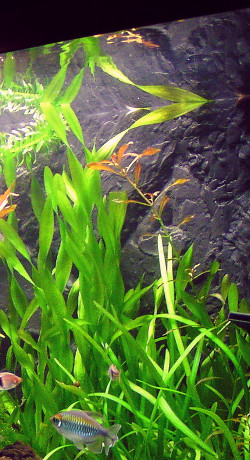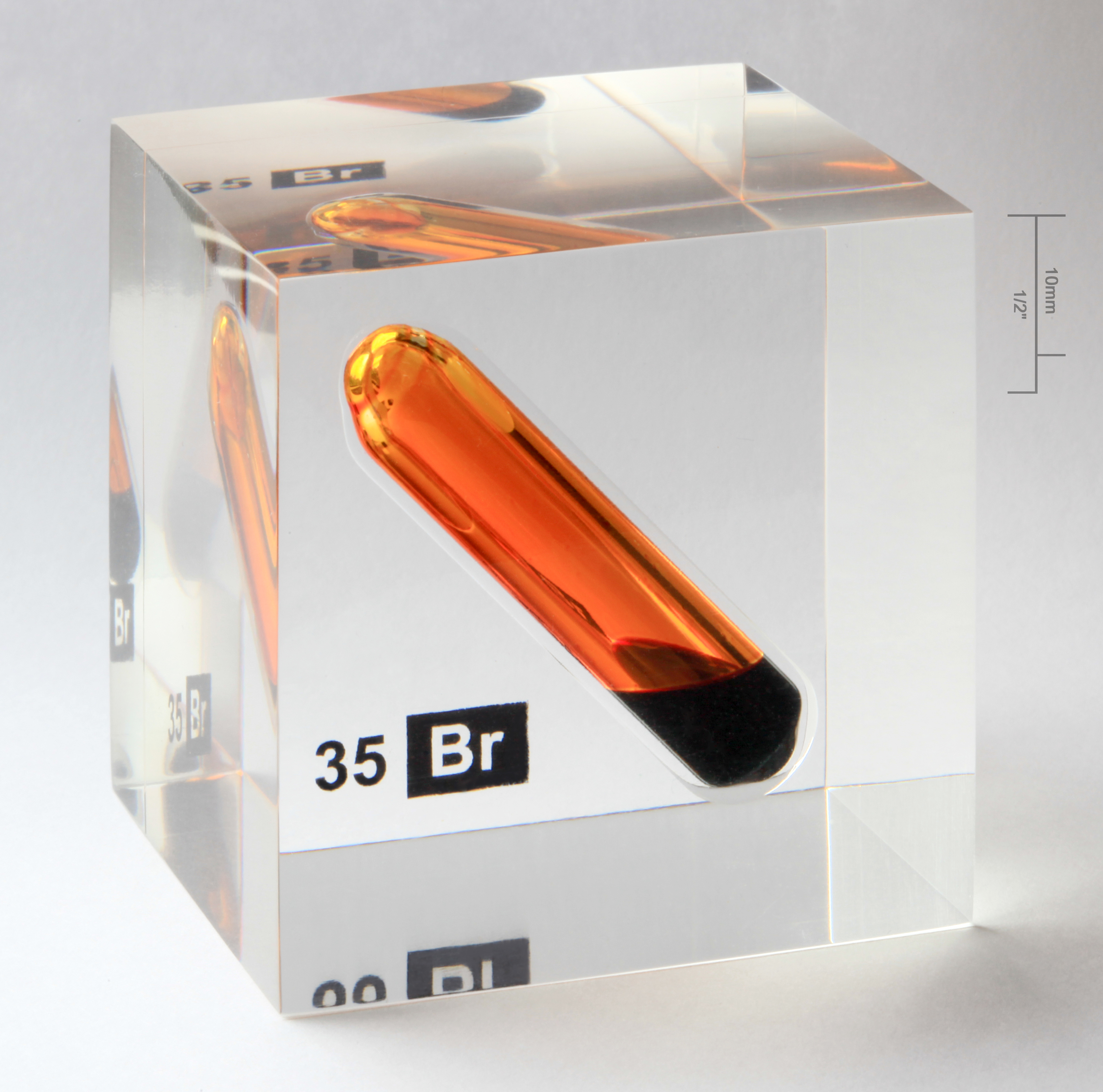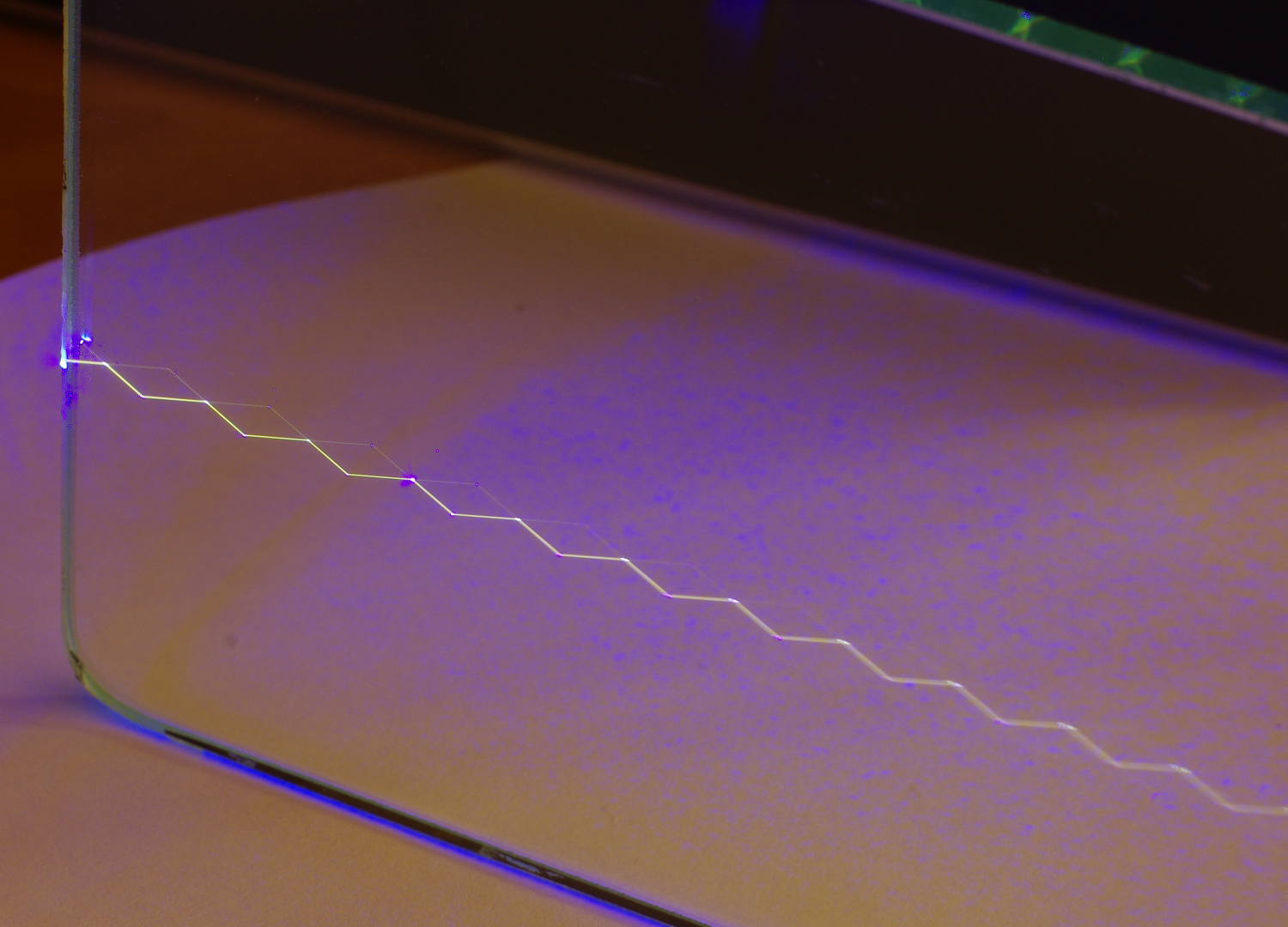|
Uniformity Tape
Uniformity tape is a microstructured thin-film mechanism for mixing and diffusing the light generated by light-emitting diodes (LEDs) in edge-lit digital displays, including monitors, televisions and signage. Purpose Compared to other sources of illumination, such as fluorescent and incandescent bulbs, LEDs are energy efficient and increasingly inexpensive. As hard-point light sources, however, LEDs have several significant limitations in edge-lit digital displays. First, the light generated by LEDs must be spread evenly to all parts of the display by a light guide (typically a plate of poly(methyl methacrylate)), which transports light by total internal reflection. Extraction patterns on the surface of the light-guide help to distribute the light evenly. However, even with a light guide, dark zones can be noticeable along the injection edge closest to the LEDs. The wmore widely spaced the LEDs are, the more pronounced the dark zones, but closely packed LEDs are less energy-effi ... [...More Info...] [...Related Items...] OR: [Wikipedia] [Google] [Baidu] |
Light-emitting Diode
A light-emitting diode (LED) is a semiconductor device that emits light when current flows through it. Electrons in the semiconductor recombine with electron holes, releasing energy in the form of photons. The color of the light (corresponding to the energy of the photons) is determined by the energy required for electrons to cross the band gap of the semiconductor. White light is obtained by using multiple semiconductors or a layer of light-emitting phosphor on the semiconductor device. Appearing as practical electronic components in 1962, the earliest LEDs emitted low-intensity infrared (IR) light. Infrared LEDs are used in remote-control circuits, such as those used with a wide variety of consumer electronics. The first visible-light LEDs were of low intensity and limited to red. Early LEDs were often used as indicator lamps, replacing small incandescent bulbs, and in seven-segment displays. Later developments produced LEDs available in visible, ultraviolet ... [...More Info...] [...Related Items...] OR: [Wikipedia] [Google] [Baidu] |
Digital Display
A display device is an output device for presentation of information in visual or tactile form (the latter used for example in tactile electronic displays for blind people). When the input information that is supplied has an electrical signal the display is called an ''electronic display''. Common applications for '' electronic visual displays'' are television sets or computer monitors. Types of electronic displays In use These are the technologies used to create the various displays in use today. * Liquid crystal display (LCD) ** Light-emitting diode (LED) backlit LCD ** Thin-film transistor (TFT) LCD ** Quantum dot (QLED) display * Light-emitting diode (LED) display ** OLED display ** AMOLED display ** Super AMOLED display Segment displays Some displays can show only digits or alphanumeric characters. They are called segment displays, because they are composed of several segments that switch on and off to give appearance of desired glyph. The segments are u ... [...More Info...] [...Related Items...] OR: [Wikipedia] [Google] [Baidu] |
Uniformity Tape-Wiki-fig1
Uniformity may refer to: * Distribution uniformity, a measure of how uniformly water is applied to the area being watered * Religious uniformity, the promotion of one state religion, denomination, or philosophy to the exclusion of all other religious beliefs * Retention uniformity, a concept in thin layer chromatography * Tire uniformity, a concept in vehicle technology * Uniformity (chemistry), a measure of the homogeneity of a substance's composition or character * Uniformity (complexity), a concept in computational complexity theory * Uniformity (philosophy), the concept that the same natural laws and processes that operate in the universe now have always operated in the universe * Uniformity (topology), a concept in the mathematical field of topology * Uniformity of motive, a concept in astrobiology See also * Uniform (other) * Diversity (other) Diversity, diversify, or diverse may refer to: Business *Diversity (business), the inclusion of people of diff ... [...More Info...] [...Related Items...] OR: [Wikipedia] [Google] [Baidu] |
Poly(methyl Methacrylate)
Poly(methyl methacrylate) (PMMA) belongs to a group of materials called engineering plastics. It is a transparent thermoplastic. PMMA is also known as acrylic, acrylic glass, as well as by the trade names and brands Crylux, Plexiglas, Acrylite, Astariglas, Lucite, Perclax, and Perspex, among several others ( see below). This plastic is often used in sheet form as a lightweight or shatter-resistant alternative to glass. It can also be used as a casting resin, in inks and coatings, and for many other purposes. Although not a type of familiar silica-based glass, the substance, like many thermoplastics, is often technically classified as a type of glass, in that it is a non-crystalline vitreous substance—hence its occasional historic designation as ''acrylic glass''. Chemically, it is the synthetic polymer of methyl methacrylate. It was developed in 1928 in several different laboratories by many chemists, such as William Chalmers, Otto Röhm, and Walter Bauer, and first brou ... [...More Info...] [...Related Items...] OR: [Wikipedia] [Google] [Baidu] |
Total Internal Reflection
Total internal reflection (TIR) is the optical phenomenon in which waves arriving at the interface (boundary) from one medium to another (e.g., from water to air) are not refracted into the second ("external") medium, but completely reflected back into the first ("internal") medium. It occurs when the second medium has a higher wave speed (i.e., lower refractive index) than the first, and the waves are incident at a sufficiently oblique angle on the interface. For example, the water-to-air surface in a typical fish tank, when viewed obliquely from below, reflects the underwater scene like a mirror with no loss of brightness (Fig.1). TIR occurs not only with electromagnetic waves such as light and microwaves, but also with other types of waves, including sound and water waves. If the waves are capable of forming a narrow beam (Fig.2), the reflection tends to be described in terms of " rays" rather than waves; in a medium whose properties are independent of direction, such as ... [...More Info...] [...Related Items...] OR: [Wikipedia] [Google] [Baidu] |
Uniformity Tape-Wiki-fig2
Uniformity may refer to: * Distribution uniformity, a measure of how uniformly water is applied to the area being watered * Religious uniformity, the promotion of one state religion, denomination, or philosophy to the exclusion of all other religious beliefs * Retention uniformity, a concept in thin layer chromatography * Tire uniformity, a concept in vehicle technology * Uniformity (chemistry), a measure of the homogeneity of a substance's composition or character * Uniformity (complexity), a concept in computational complexity theory * Uniformity (philosophy), the concept that the same natural laws and processes that operate in the universe now have always operated in the universe * Uniformity (topology), a concept in the mathematical field of topology * Uniformity of motive, a concept in astrobiology See also * Uniform (other) * Diversity (other) Diversity, diversify, or diverse may refer to: Business *Diversity (business), the inclusion of people of diff ... [...More Info...] [...Related Items...] OR: [Wikipedia] [Google] [Baidu] |
Backlight
A backlight is a form of illumination used in liquid crystal displays (LCDs). As LCDs do not produce light by themselves—unlike, for example, cathode ray tube (CRT), plasma (PDP) or OLED displays—they need illumination ( ambient light or a special light source) to produce a visible image. Backlights illuminate the LCD from the side or back of the display panel, unlike frontlights, which are placed in front of the LCD. Backlights are used in small displays to increase readability in low light conditions such as in wristwatches, and are used in smart phones, computer displays and LCD televisions to produce light in a manner similar to a CRT display. A review of some early backlighting schemes for LCDs is given in a report ''Engineering and Technology History'' by Peter J. Wild. Simple types of LCDs such as in pocket calculators are built without an internal light source, requiring external light sources to convey the display image to the user. Most LCD screens, however, a ... [...More Info...] [...Related Items...] OR: [Wikipedia] [Google] [Baidu] |
Digital Display
A display device is an output device for presentation of information in visual or tactile form (the latter used for example in tactile electronic displays for blind people). When the input information that is supplied has an electrical signal the display is called an ''electronic display''. Common applications for '' electronic visual displays'' are television sets or computer monitors. Types of electronic displays In use These are the technologies used to create the various displays in use today. * Liquid crystal display (LCD) ** Light-emitting diode (LED) backlit LCD ** Thin-film transistor (TFT) LCD ** Quantum dot (QLED) display * Light-emitting diode (LED) display ** OLED display ** AMOLED display ** Super AMOLED display Segment displays Some displays can show only digits or alphanumeric characters. They are called segment displays, because they are composed of several segments that switch on and off to give appearance of desired glyph. The segments are u ... [...More Info...] [...Related Items...] OR: [Wikipedia] [Google] [Baidu] |
Light-emitting Diode
A light-emitting diode (LED) is a semiconductor device that emits light when current flows through it. Electrons in the semiconductor recombine with electron holes, releasing energy in the form of photons. The color of the light (corresponding to the energy of the photons) is determined by the energy required for electrons to cross the band gap of the semiconductor. White light is obtained by using multiple semiconductors or a layer of light-emitting phosphor on the semiconductor device. Appearing as practical electronic components in 1962, the earliest LEDs emitted low-intensity infrared (IR) light. Infrared LEDs are used in remote-control circuits, such as those used with a wide variety of consumer electronics. The first visible-light LEDs were of low intensity and limited to red. Early LEDs were often used as indicator lamps, replacing small incandescent bulbs, and in seven-segment displays. Later developments produced LEDs available in visible, ultraviolet ... [...More Info...] [...Related Items...] OR: [Wikipedia] [Google] [Baidu] |
Poly(methyl Methacrylate)
Poly(methyl methacrylate) (PMMA) belongs to a group of materials called engineering plastics. It is a transparent thermoplastic. PMMA is also known as acrylic, acrylic glass, as well as by the trade names and brands Crylux, Plexiglas, Acrylite, Astariglas, Lucite, Perclax, and Perspex, among several others ( see below). This plastic is often used in sheet form as a lightweight or shatter-resistant alternative to glass. It can also be used as a casting resin, in inks and coatings, and for many other purposes. Although not a type of familiar silica-based glass, the substance, like many thermoplastics, is often technically classified as a type of glass, in that it is a non-crystalline vitreous substance—hence its occasional historic designation as ''acrylic glass''. Chemically, it is the synthetic polymer of methyl methacrylate. It was developed in 1928 in several different laboratories by many chemists, such as William Chalmers, Otto Röhm, and Walter Bauer, and first brou ... [...More Info...] [...Related Items...] OR: [Wikipedia] [Google] [Baidu] |
Total Internal Reflection
Total internal reflection (TIR) is the optical phenomenon in which waves arriving at the interface (boundary) from one medium to another (e.g., from water to air) are not refracted into the second ("external") medium, but completely reflected back into the first ("internal") medium. It occurs when the second medium has a higher wave speed (i.e., lower refractive index) than the first, and the waves are incident at a sufficiently oblique angle on the interface. For example, the water-to-air surface in a typical fish tank, when viewed obliquely from below, reflects the underwater scene like a mirror with no loss of brightness (Fig.1). TIR occurs not only with electromagnetic waves such as light and microwaves, but also with other types of waves, including sound and water waves. If the waves are capable of forming a narrow beam (Fig.2), the reflection tends to be described in terms of " rays" rather than waves; in a medium whose properties are independent of direction, such as ... [...More Info...] [...Related Items...] OR: [Wikipedia] [Google] [Baidu] |





